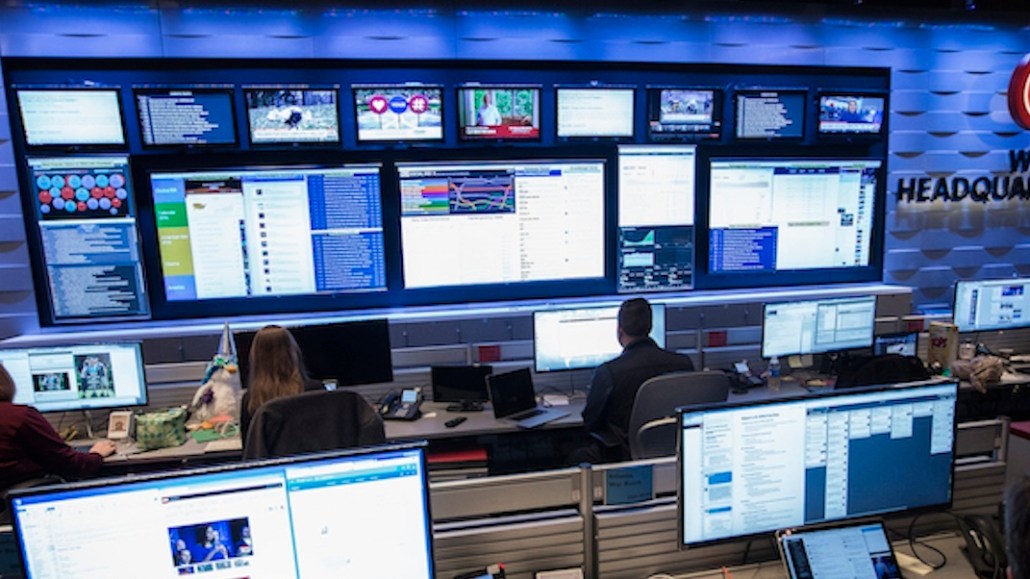Insights from CTV leaders at Dentsu, Horizon Media and more
Facing the limits of scale, CNN puts focus on direct audience connections

CNN, like other publishers, has started to realize the limits of scale.
The network has built a massive audience online and on platforms like Facebook and Twitter, but it wasn’t becoming a daily habit. Traffic would spike during breaking news, but then fall off. Individual departments like news and social were doing audience development work on their own, but they weren’t working in concert.
It’s been trying to course correct. About a year ago, CNN hired Chris Herbert from The Weather Channel to build an audience development team, among other things. Herbert, svp of digital operations and strategy, brought on Alan Segal in September as vp of audience development to strengthen direct relationships with CNN’s audience through products like newsletters and podcasts; grow engagement during non-breaking news periods to give advertisers more predictability; and double audience-based sales. Segal has created a 15-person team including data scientists and analytics experts and is expected to roughly double that over the next two years.
“How we see audience development is to use data to develop a news habit for the next generation and improve monetization,” said Herbert, who reports to Andrew Morse, CNN’s digital GM. “We’re so large and we have such a big audience today, but we don’t necessarily have some of the background our competitors in print have about knowing their audience. The shift we’re making is focusing less on overall scale in the form of uniques to looking at engagement, daily active uniques, time spend in video.”
To do this, CNN needs to make audience development a bigger part of the culture. Two years ago, it created what it called a “war room,” which entailed putting up monitors at CNNMoney that blinked with online and social media metrics. The idea was that the data would be used to inform the editorial strategy in real time. But its benefits were limited. Segal’s team was purposely made independent of sales and edit so it can focus on making the best user experience. Still, its members sit in the newsroom and take part in morning editorial calls and business development, product and sales meetings.
“It was a great effort in terms of shifting the culture,” Herbert said. “What we realized is, it’s not enough to put the numbers on the board. You have to ingrain them in the daily workflow.”
CNN said it’s too early to point to any big audience or financial results from the audience development group, but it’s had some small successes. Analyzing its newsletters led to a new way of doing links that would drive more clicks to CNN.com. Its data led to changes in the homepage that goosed article engagement. And it tested a content recirculation module and found that it didn’t actually help engagement the way it was intended — preventing a potentially costly mistake.
But CNN is at its core a video company, so naturally, video will be a big part of the team’s focus. It’s been drilling down to see not just how many people start a video but when they drop off. With so many platforms pushing video in different ways, CNN has its work cut out for it here.
“Every single platform has a different audience, and there are so many types of video consumers,” Segal said. “We have to understand so many platforms and deliver it in a way that’s right for that platform.”
Along with engagement, Segal’s team has financial goals. CNN used to sell digital advertising based on its scale, but will now slice its audience into distinct groups like, say, political junkies to sell against endemic rivals, like Politico, in this case.
It’s not a bad idea for CNN and publishers like it to use their scale to identify niche audiences, said Jeremy Tate, group director of media for GroupeConnect. Advertisers still care about context, but if they can reach the same audience elsewhere for less, it can complement an endemic ad buy.
“Contextual relevance is still important,” he said. “That’s a limitation of audience-based buying, but if CNN can marry signals people give off with finding them in the right context, that’s an opportunity.”
More in Media

Digiday+ Research: Publishers pull back their dependence on digital revenue
After a year in which publishers shifted their revenue dependence away from traditional channels and toward digital channels, 2025 has seen a shift back toward more of a balance between traditional and digital revenue sources.

LinkedIn makes it easier for creators to track performance across platforms
Creator data is becoming more accessible to third-party vendors via a new API — another step in LinkedIn’s creator platform evolution.

Ad Tech Briefing: The ‘plumbers’ posing as the unlikely saviors of the internet
After several false dawns, can Cloudflare’s ‘anti-AI scraping tool’ finally offer publishers a road to commercial redemption?








